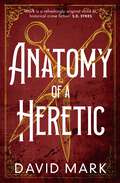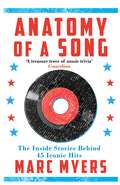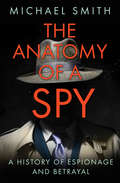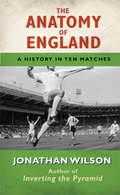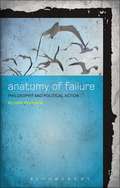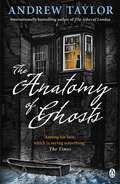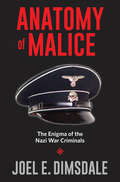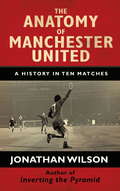- Table View
- List View
Anatomy and Anatomists in Early Modern Spain (The History of Medicine in Context)
by Bjørn Okholm SkaarupTaking the Vesalian anatomical revolution as its point of departure, this volume charts the apparent rise and fall of anatomy studies within universities in sixteenth-century Spain, focussing particularly on primary sources from 1550 to 1600. In doing so, it both clarifies the Spanish contribution to the field of anatomy and disentangles the distorted political and historiographical viewpoints emerging from previous research. Studies of early modern Iberian science have only been carried out coherently and collaboratively in the last few decades, even though fierce debates on the subject have dominated Spanish historiography for more than two centuries. In the field of anatomy studies, many uninformed and biased readings of archival sources have resulted in a very confused picture of the practice of dissection and the teaching of anatomy in the Iberian Peninsula, in which the highly complex conditions of anatomical research within Spain’s national context are often oversimplified. The new empirical evidence that this book brings to light suggests a far more multifaceted narrative of Iberian Renaissance anatomy than has been presented to date.
Anatomy and Anatomists in Early Modern Spain (The History of Medicine in Context)
by Bjørn Okholm SkaarupTaking the Vesalian anatomical revolution as its point of departure, this volume charts the apparent rise and fall of anatomy studies within universities in sixteenth-century Spain, focussing particularly on primary sources from 1550 to 1600. In doing so, it both clarifies the Spanish contribution to the field of anatomy and disentangles the distorted political and historiographical viewpoints emerging from previous research. Studies of early modern Iberian science have only been carried out coherently and collaboratively in the last few decades, even though fierce debates on the subject have dominated Spanish historiography for more than two centuries. In the field of anatomy studies, many uninformed and biased readings of archival sources have resulted in a very confused picture of the practice of dissection and the teaching of anatomy in the Iberian Peninsula, in which the highly complex conditions of anatomical research within Spain’s national context are often oversimplified. The new empirical evidence that this book brings to light suggests a far more multifaceted narrative of Iberian Renaissance anatomy than has been presented to date.
Anatomy and the Organization of Knowledge, 1500–1850 ("The Body, Gender and Culture")
by Matthew Landers Brian MuñozAcross early modern Europe, the growing scientific practice of dissection prompted new and insightful ideas about the human body. This collection of essays explores the impact of anatomical knowledge on wider issues of learning and culture.
Anatomy and the Organization of Knowledge, 1500–1850 ("The Body, Gender and Culture" #9)
by Matthew Landers Brian MuñozAcross early modern Europe, the growing scientific practice of dissection prompted new and insightful ideas about the human body. This collection of essays explores the impact of anatomical knowledge on wider issues of learning and culture.
Anatomy of a Heretic
by David MarkA thrilling historical adventure that sees two assassins go head-to-head on the open seas, from Sunday Times bestselling author and Richard & Judy Book Club pick David Mark. London, 1628. Nicolaes de Pelgrom, assassin and devoted servant of George Villiers, will do whatever his master asks of him – even if that means enduring the perilous voyage to the Indies to exact a grieving widow's revenge.Making that same journey is Jeronimus Cornelisz, a conniving apothecary determined to escape the backstreets of Amsterdam and become rich beyond imagination. Hired by a criminal mastermind to escort precious cargo to the Indies, he will kill anyone who stands in his way.When these assassins clash, so too do their missions. One cannot succeed without killing the other. In this deadly game, who will triumph and who will die? And are they even the only players?'A fantastic achievement - dark and compelling with characters you will never forget.' Elly Griffiths 'David Mark's books are always taut, intelligent page-turners, so it's a joy that he's turned his pen and his talents to historical fiction.' Abir Mukherjee 'Sumptuous and decadent... [a] lush masterpiece.' Historical Novel SocietyReviews for David Mark:'Mark is the king of grimy historical crime.' Alex Reeve 'Breathtaking.' Peter May 'Mark is a wonderfully descriptive writer.' Peter James 'Brilliantly written – a cracking story.' Richard Madeley
Anatomy of a Massacre: How the SS Got Away with War Crimes in Italy
by Christian JenningsThere isn’t any triumph, there isn’t any happy ending in the story of Sant’Anna di Stazzema, but there is a resolute affirmation of the continuing strength of the human spirit. At dawn on 12 August 1944, German SS troops arrived in the Tuscan mountain village of Sant’Anna di Stazzema. On arrival, they proceeded to murder up to 560 Italian civilians in the olive groves and chestnut woods of the small hamlet. The victims were women, the elderly and over eighty children. One was a baby barely three weeks old. It was the most high-profile massacre committed by the Nazis in Italy – and yet, despite three separate war crimes investigations, the Sant’Anna killers escaped justice. Sixty years later, ten of the SS men who were at Sant’Anna were sentenced to life imprisonment in absentia by Italian courts, but they died free. Anatomy of a Massacre tells the full story of what happened at Sant’Anna di Stazzema – from Tuscany to Rome and Germany – and tries to answer the question: why were the survivors denied justice?
The Anatomy of a Moment: Thirty-five Minutes in History and Imagination
by Javier CercasIn February 1981, Spain was still emerging from Franco's shadow, holding a democratic vote for the new prime minister. On the day of the vote in Parliament, while the session was being filmed by TV cameras, a band of right-wing soldiers burst in with automatic weapons, ordering everyone to get down. Only three men defied the order. For thirty-five minutes, as the cameras rolled, they stayed in their seats.Critically adored novelist Javier Cercas originally set out to write a novel about this pivotal moment, but determined it had already gained an air of myth, or, through the annual broadcast of video clips, had at least acquired the fictional taint of reality television. Cercas turned to nonfiction, and his vivid descriptions of the archival footage frame a narrative that traverses the line between history and art, creating a daring new account of this watershed moment in modern Spanish history.The Anatomy of a Moment caused a sensation upon its publication in Spain, selling hundreds of thousands of copies. The story will be new to many American readers, but the book stands resolutely on its own as a compelling literary inquest of national myth, personal memory, political spectacle, and reality itself.
Anatomy of a Nation: A History of British Identity in 50 Documents
by Dominic SelwoodFrom an obscure, misty archipelago on the fringes of the Roman world to history's largest empire and originator of the world's mongrel, magpie language - this is Britain's past. But, today, Britain is experiencing an acute trauma of identity, pulled simultaneously towards its European, Atlantic and wider heritages. To understand the dislocation and collapse, we must look back: to Britain's evolution, achievements, complexities and tensions. In a ground-breaking new take on British identity, historian and barrister Dominic Selwood explores over 950,000 years of British history by examining 50 documents that tell the story of what makes Britain unique.Some of these documents are well-known. Most are not. Each reveal something important about Britain and its people. From Anglo-Saxon poetry, medieval folk music and the first Valentine's Day letter to the origin of computer code, Hitler's kill list of prominent Britons, the Sex Pistols' graphic art and the Brexit referendum ballot paper, Anatomy of a Nation reveals a Britain we have never seen before. People are at the heart of the story: a female charioteer queen from Wetwang, a plague surviving graffiti artist, a drunken Bible translator, outlandish Restoration rakehells, canting criminals, the eccentric fathers of modern typography and the bankers who caused the finance crisis.Selwood vividly blends human stories with the selected 50 documents to bring out the startling variety and complexity of Britain's achievements and failures in a fresh and incisive insight into the British psyche. This is history the way it is supposed to be told: a captivating and entertaining account of the people that built Britain.
Anatomy of a Song: The Inside Stories Behind 45 Iconic Hits
by Marc MyersSongs that sell the most copies become hits, but some of those hits transcend commercial value, touching a generation of listeners and altering the direction of music. In Anatomy of a Song, writer and music historian Marc Myers tells the stories behind fifty rock, pop, R&B, country and reggae hits through intimate interviews with the artists who wrote and recorded them.Mick Jagger, Jimmy Page, the Clash, Smokey Robinson, Grace Slick, Roger Waters, Joni Mitchell, Steven Tyler, Rod Stewart, Elvis Costello and many other leading artists reveal the inspirations, struggles and techniques behind their influential works.
The Anatomy of a Spy: A History of Espionage and Betrayal
by Michael SmithIN this compelling investigation, author Michael Smith explores the critical moment in a spy’s life: that split-second decision to embrace a double life; to cheat and hide and hurt; to risk disgrace – even death – without any guarantee of being rewarded or even recognised. Each chapter centres on a number of different spies, following the path they took that led, finally, to the point of no return. Were they propelled by personal convictions? Blackmailed and left without a choice? Too desperate for money to think about the consequences? Through in-depth insider knowledge, Michael Smith also uncovers new and unknown cases, including a spy inside ISIS, President Trump’s links with Russia and Edward Snowden’s role as a whistle-blower, to offer compelling psychological portraits of these men and women, homing unerringly on the fault-lines and shady corners of their characters, their weaknesses and their strengths, the lies they tell other people, and the lies they always end up telling themselves.
The Anatomy of an International Monetary Regime: The Classical Gold Standard, 1880-1914
by Giulio M. GallarottiWidely considered the crowning achievement in the history of international monetary relations, the classical gold standard (1880-1914) has long been treated like a holy relic. Its veneration, however, has done more to obscure than to reveal the actual nature of the era's monetary system. In The Anatomy of an International Monetary Regime, Giulio M. Gallarotti addresses the nature of the classical gold standard in its international context, offering the first comprehensive and systematic treatment of the subject. Three fundamental questions are essential to the discussion: How did the regime originate? How did it work? Why did it persist? Gallarotti uses an interdisciplinary approach that draws upon politics, economics, and ideology to explain the answers. He challenges traditional assumptions about the period, arguing that cooperation among nations or central banks was not a principal factor in either the origin or stability of the system, and that neither the British state nor the Bank of England were the leaders or managers of the gold standard. Rather, a decentralized process involving the status of gold, industrialization and economic development, the politics of gold, and liberal economic ideology provided converging incentives for starting and maintaining the system. Gallarotti's study presents the most comprehensive and interdisciplinary examination available of the nature of monetary relations in the four decades before World War I. His important, revisionist view will alter the way we think about a crucial period in the growth of the international monetary system. It will be essential reading for scholars and students of economic history and policy.
The Anatomy of Blackness: Science and Slavery in an Age of Enlightenment
by Andrew S. CurranThis volume examines the Enlightenment-era textualization of the Black African in European thought. Andrew S. Curran rewrites the history of blackness by replicating the practices of eighteenth-century readers. Surveying French and European travelogues, natural histories, works of anatomy, pro- and anti-slavery tracts, philosophical treatises, and literary texts, Curran shows how naturalists and philosophes drew from travel literature to discuss the perceived problem of human blackness within the nascent human sciences, describes how a number of now-forgotten anatomists revolutionized the era’s understanding of black Africans, and charts the shift of the slavery debate from the moral, mercantile, and theological realms toward that of the "black body" itself. In tracing this evolution, he shows how blackness changed from a mere descriptor in earlier periods into a thing to be measured, dissected, handled, and often brutalized. Penetrating and comprehensive, The Anatomy of Blackness shows that, far from being a monolithic idea, eighteenth-century Africanist discourse emerged out of a vigorous, varied dialogue that involved missionaries, slavers, colonists, naturalists, anatomists, philosophers, and Africans themselves.
The Anatomy of Blackness: Science and Slavery in an Age of Enlightenment
by Andrew S. CurranThis volume examines the Enlightenment-era textualization of the Black African in European thought. Andrew S. Curran rewrites the history of blackness by replicating the practices of eighteenth-century readers. Surveying French and European travelogues, natural histories, works of anatomy, pro- and anti-slavery tracts, philosophical treatises, and literary texts, Curran shows how naturalists and philosophes drew from travel literature to discuss the perceived problem of human blackness within the nascent human sciences, describes how a number of now-forgotten anatomists revolutionized the era’s understanding of black Africans, and charts the shift of the slavery debate from the moral, mercantile, and theological realms toward that of the "black body" itself. In tracing this evolution, he shows how blackness changed from a mere descriptor in earlier periods into a thing to be measured, dissected, handled, and often brutalized. Penetrating and comprehensive, The Anatomy of Blackness shows that, far from being a monolithic idea, eighteenth-century Africanist discourse emerged out of a vigorous, varied dialogue that involved missionaries, slavers, colonists, naturalists, anatomists, philosophers, and Africans themselves.
The Anatomy of Dance Discourse: Literary and Philosophical Approaches to Dance in the Later Graeco-Roman World
by Karin SchlapbachWithin the newly thriving field of ancient Greek and Roman performance and dance studies, The Anatomy of Dance Discourse offers a fresh and original perspective on ancient perceptions of dance. Focusing on the second century CE, it provides an overview of the dance discourse of this period and explores the conceptualization of dance across an array of different texts, from Plutarch and Lucian of Samosata, to the apocryphal Acts of John, Longus, and Apuleius. The volume is divided into two parts: while the second part discusses ekphraseis of dance performance in prose and poetry of the Roman imperial period, the first delves more deeply into an examination of how both philosophical and literary treatments of dance interacted with other areas of cultural expression, whether language and poetry, rhetoric and art, or philosophy and religion. Its distinctive contribution lies in this juxtaposition of ancient theorizations of dance and philosophical analyses of the medium with literary depictions of dance scenes and performances, and it attends not only to the highly encoded genre of pantomime, which dominated the stage in the Roman Empire, but also to acrobatic, non-representational dances. This twofold nature of dance sparked highly sophisticated reflections on the relationship between dance and meaning in the ancient world, and the volume defends the novel claim that in the imperial period it became more and more palpable that dance, unlike painting or sculpture, could be representational or not: a performance of nothing but itself. It argues that dance was understood as a practice in which human beings, whether as dancers or spectators, are confronted with the irreducible reality of their own physical existence, which is constantly changing, and that its way to cognition and action is physical experience.
The Anatomy of Dance Discourse: Literary and Philosophical Approaches to Dance in the Later Graeco-Roman World
by Karin SchlapbachWithin the newly thriving field of ancient Greek and Roman performance and dance studies, The Anatomy of Dance Discourse offers a fresh and original perspective on ancient perceptions of dance. Focusing on the second century CE, it provides an overview of the dance discourse of this period and explores the conceptualization of dance across an array of different texts, from Plutarch and Lucian of Samosata, to the apocryphal Acts of John, Longus, and Apuleius. The volume is divided into two parts: while the second part discusses ekphraseis of dance performance in prose and poetry of the Roman imperial period, the first delves more deeply into an examination of how both philosophical and literary treatments of dance interacted with other areas of cultural expression, whether language and poetry, rhetoric and art, or philosophy and religion. Its distinctive contribution lies in this juxtaposition of ancient theorizations of dance and philosophical analyses of the medium with literary depictions of dance scenes and performances, and it attends not only to the highly encoded genre of pantomime, which dominated the stage in the Roman Empire, but also to acrobatic, non-representational dances. This twofold nature of dance sparked highly sophisticated reflections on the relationship between dance and meaning in the ancient world, and the volume defends the novel claim that in the imperial period it became more and more palpable that dance, unlike painting or sculpture, could be representational or not: a performance of nothing but itself. It argues that dance was understood as a practice in which human beings, whether as dancers or spectators, are confronted with the irreducible reality of their own physical existence, which is constantly changing, and that its way to cognition and action is physical experience.
Anatomy of Dissent in Islamic Societies: Ibadism, Rebellion, and Legitimacy
by A. SouaiaiaAnatomy of Dissent in Islam is an interdisciplinary study of political and legal dissent in Islamic civilization from the seventh century on. (7th century). Using Ibadism as a case study, this work explores the events and teachings that shaped legitimacy and rebellion, orthodoxy and sectarianism, and law and culture in Islamic societies.
The Anatomy of England: A History in Ten Matches
by Jonathan WilsonHaving invented the game, everything that has followed for England and its national football team has been something of an anticlimax. There was, of course, the golden summer of 1966, and the great period of English dominance on the world stage, which fell roughly between 1886 and 1900, when England won 35 of their 40 internationals ... But before long foreign teams, with their insistence on progressive 'tactics', began to pose a few questions. And much of what followed for England constituted a series of false dawns.In THE ANATOMY OF ENGLAND Jonathan Wilson seeks to place the bright spots in context. Time and again, progressive coaches have been spurned by England - technique being all very well, but what really matters is pluck and 'organised muscularity', or, to quote Jimmy Hogan's chairman at Aston Villa in 1936: 'I've no time for these theories about football. Just get the ball in the bloody net.'Wilson takes ten key England fixtures and explores how what actually happened on the pitch shaped the future of the English game. Bursting with insight and critical detail, yet imbued with a wry affection, this is a history of England like none before.
Anatomy of Failure: Philosophy and Political Action
by Oliver FelthamModern liberalism begins in the forgetting of the English Revolution. Anatomy of Failure seeks to right that wrong by exploring the concept of political action, playing its history against its philosophy. The 1640s are a period of institutional failure and political disaster: the country plunges into civil war, every agent is naked. Established procedures are thrown aside and the very grounds for action are fiercely debated and recast. Five queries emerge in the experience of the New Model Army, five queries that outline an anatomy of failure, isolating the points at which actors disagree, conflict flares up, and alliances dissolve: Who can act? On what grounds? Who is right about what is to be done? Why do we succeed or fail? If you and I split, were we ever united, and to what end? The application of these questions to the Leveller-agitator writings, and then to Thomas Hobbes and John Locke's philosophies, generates models of political action. No mere philosophical abstractions, the Hobbesian and Lockean models of sovereign and contractual action have dominated the very practice of politics for centuries. Today it is time to recuperate the Leveller-agitator model of joint action, a model unique in its adequacy to the threat of failure and in its vocation for building the common-wealth. Anatomy of Failure is ideal for upper-level undergraduates and postgraduates taking courses in Contemporary Political Philosophy, Continental Philosophy, Modern European Philosophy, Contemporary French Philosophy, Critical Theory and Radical Political Thought.
Anatomy of Failure: Philosophy and Political Action
by Oliver FelthamModern liberalism begins in the forgetting of the English Revolution. Anatomy of Failure seeks to right that wrong by exploring the concept of political action, playing its history against its philosophy. The 1640s are a period of institutional failure and political disaster: the country plunges into civil war, every agent is naked. Established procedures are thrown aside and the very grounds for action are fiercely debated and recast. Five queries emerge in the experience of the New Model Army, five queries that outline an anatomy of failure, isolating the points at which actors disagree, conflict flares up, and alliances dissolve: Who can act? On what grounds? Who is right about what is to be done? Why do we succeed or fail? If you and I split, were we ever united, and to what end? The application of these questions to the Leveller-agitator writings, and then to Thomas Hobbes and John Locke's philosophies, generates models of political action. No mere philosophical abstractions, the Hobbesian and Lockean models of sovereign and contractual action have dominated the very practice of politics for centuries. Today it is time to recuperate the Leveller-agitator model of joint action, a model unique in its adequacy to the threat of failure and in its vocation for building the common-wealth. Anatomy of Failure is ideal for upper-level undergraduates and postgraduates taking courses in Contemporary Political Philosophy, Continental Philosophy, Modern European Philosophy, Contemporary French Philosophy, Critical Theory and Radical Political Thought.
The Anatomy of Fascism
by Robert O. PaxtonFascism was the major political invention of the twentieth century and the source of much of its pain. How can we try to comprehend its allure and its horror? Is it a philosophy, a movement, an aesthetic experience? What makes states and nations become fascist?Acclaimed historian Robert O. Paxton shows that in order to understand fascism we must look at it in action - at what it did, as much as what it said it was about. He explores its falsehoods and common threads; the social and political base that allowed it to prosper; its leaders and internal struggles; how it manifested itself differently in each country - France, Britain, the low countries, Eastern Europe, even Latin America as well as Italy and Germany; how fascists viewed the Holocaust; and, finally, whether fascism is still possible in today's world.Offering a bold new interpretation of the fascist phenomenon, this groundbreaking book will overturn our understanding of twentieth-century history.
The Anatomy of Ghosts
by Andrew TaylorThe Anatomy of Ghosts is a gripping historical mystery from the bestselling author of The Ashes of London1786, Jerusalem College, Cambridge.The ghost of murdered Sylvia Whichcote is sighted prowling the grounds by commoner Frank Oldershaw. Worried her son is descending into madness, Frank's anxious mother employs rationalist John Holdsworth to investigate the sighting, throwing the uneasy status quo at the college into chaos.For the sinister Holy Ghost Club governs the privileged life at Jerusalem. Pursued by the ghost of his dead wife, Maria, and Elinor, the very-much-alive Master's wife, Holdsworth must unravel the circumstances surrounding Sylvia's death or succumb to the hauntings himself . . .
The Anatomy of Israel's Survival
by Hirsh GoodmanThe question "Can Israel survive?” has echoed loud for Israelis-and Jews, their supporters and adversaries worldwide-since the Holocaust. The recent upheavals in Egypt, Tunisia and beyond have raised it anew. Israeli journalist and security analyst Hirsh Goodman set out to answer it, through rigorous factual assessment of each of the challenges his country faces, and by consulting experts and participants on all sides of every complex issue. But what he learned was that this once 'essential question' has become a dangerous distraction. In this provocative and deeply informed book, Goodman shares his clarifying analyses both of recent political events and of Israel's strategic position. He shows how the country's obsession with dangers posed by outside forces has obscured the harder issues facing it from within ever since its leaders disregarded Ben Gurion's advice to leave the territories captured during the Six Day War. By yoking itself to the demographic timebomb of the West Bank and Gaza, Israel propelled itself towards an invidious choice: democracy or Jewish identity. Now, Goodman argues, Israel's survival is jeopardized more by the competence of its leaders and fissures in its social and political system than by any outside threat-even the apocalyptic-sounding ones from Iran.
Anatomy of Malice: The Enigma of the Nazi War Criminals
by Joel E. DimsdaleWhen the ashes had settled after World War II and the Allies convened an international war crimes trial in Nuremberg, a psychiatrist, Douglas Kelley, and a psychologist, Gustave Gilbert, tried to fathom the psychology of the Nazi leaders, using extensive psychiatric interviews, IQ tests, and Rorschach inkblot tests. Never before or since has there been such a detailed study of governmental leaders who orchestrated mass killings. Before the war crimes trial began, it was self-evident to most people that the Nazi leaders were demonic maniacs. But when the interviews and psychological tests were completed, the answer was no longer so clear. The findings were so disconcerting that portions of the data were hidden away for decades and the research became a topic for vituperative disputes. Gilbert thought that the war criminals’ malice stemmed from depraved psychopathology. Kelley viewed them as morally flawed, ordinary men who were creatures of their environment. Who was right? Drawing on his decades of experience as a psychiatrist and the dramatic advances within psychiatry, psychology, and neuroscience since Nuremberg, Joel E. Dimsdale looks anew at the findings and examines in detail four of the war criminals, Robert Ley, Hermann Göring, Julius Streicher, and Rudolf Hess. Using increasingly precise diagnostic tools, he discovers a remarkably broad spectrum of pathology. Anatomy of Malice takes us on a complex and troubling quest to make sense of the most extreme evil.
The Anatomy of Manchester United: A History in Ten Matches
by Jonathan WilsonAward-winning football writer Jonathan Wilson selects ten landmark matches from Manchester United's history, from the first time they lifted the FA Cup, beating Bristol City in 1909, to the Cup victory of 2016 that proved to be Louis van Gaal's last game in charge. In doing so, he identifies the pivotal moments in the club's rise to being one of the foremost teams of the twentieth century.With his trademark tactical acumen, Wilson goes back to the matches themselves and subjects them to forensic examination, re-evaluating and reassessing, and going beyond the white noise of banal player quotes and instant judgements to discover why what happened happened. It is in this way, as far as possible, a football history of a great club.And because this is Manchester United, there is additional resonance. From the completion of Old Trafford in 1910, United have had a significant financial advantage. Yet their past has not been one of sustained success. As such, their history is also, to an extent, a history of English football, with all of its possibilities and frustrations.
The Anatomy of Melancholy
by Robert BurtonCelebrating the 400th anniversary of Burton's masterpiece, this fully edited, modern edition is published as a landmark hardback volume in Penguin Classics. Robert Burton's labyrinthine, beguiling, playful masterpiece is his attempt to 'anatomize and cut up' every aspect of the condition of melancholy, from which he had suffered throughout his life. Ranging over beauty, digestion, the planets, alcohol, demons, kissing, poetry and the restorative power of books, among many other things, The Anatomy of Melancholy has fascinated figures from Samuel Johnson to Jorge Luis Borges since the seventeenth century, and remains an incomparable examination of the human condition in all its flawed, endless variety.Edited with an introduction and notes by Angus Gowland'The best book ever written' Nicholas Lezard, Guardian


